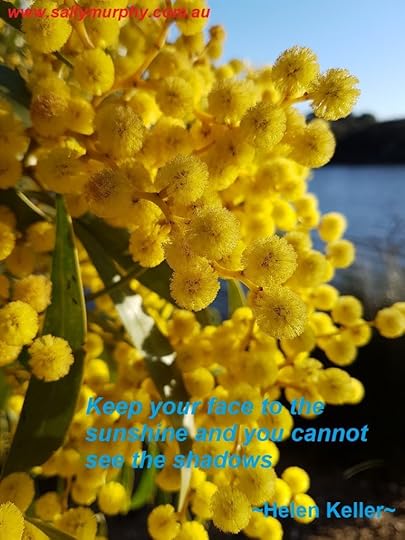Sally Murphy's Blog, page 32
October 23, 2017
Teacher Tuesday: Using Snowy’s Christmas in a Year 2 Classroom
Welcome to the fourth edition of Teacher Tuesday, where I match one of my books to a year level, and offer some activities for sharing the book in the classroom. In previous weeks I shared activities for Looking Up, Do Not Forget Australia and The Floatingest Frog.
This week, with Christmas getting ever closer, I’m focusing on a Christmas book: Snowy’s Christmas. And, because this book can be a little hard to get hold of, I am also offering signed copies, posted anywhere in Australia, for $15. You can contact me directly.
Using Snowy’s Christmas in a Year Two Classroom
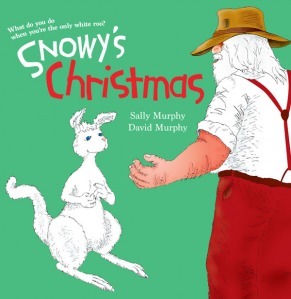
Snowy’s Christmas, text by Sally Murphy, illustrations by David Murphy
Published by Random House, 2011
ISBN: 9781921042546 (Paperback)
Format 24 page Picturebook, RRP $14.99
Available directly from me. Contact me HERE.
Blurb: ‘Snowy hopped to the billabong. The face reflected in the water was not rugged and red like the other roos, but soft and white.’ Snowy is feeling left out and doesn’t want to celebrate Christmas with his friends. But then a mysterious stranger arrives by the billabong and suddenly Snowy’s Christmas is looking up.
Sally’s Recommended Grade Levels: Year K-3, but these suggestions focus on Year 2.
Themes/Topics:
Christmas
Kangaroos
Australian animals
Mothers
Diversity
Acceptance
Curriculum Links:
Year 2 English
Identify visual representations of characters’ actions, reactions, speech and thought processes in narratives, and consider how these images add to or contradict or multiply the meaning of accompanying words (ACELA1469)
Identify aspects of different types of literary texts that entertain, and give reasons for personal preferences (ACELT159)
Before reading: Look at the front cover. Explain that Sally Murphy is the author and David Murphy is the illustrator (As an aside, because students may ask, David is Sally’s brother-in-law). Discuss: What does an author do? What does an illustrator do? Prompt students to look closely at the illustrations while the story is read, looking for anything that ways the words and pictures show the same things, and ways that the pictures show something different or extra.
During reading: First read-through – read whole story without asking questions. Let students enjoy the story.
After first read through: ask students to name any differences/similarities they saw.
Re-read, prompting students to look especially at the kangaroo characters and what their various facial and body expressions show about how they are feeling. As students contribute, discuss which expressions reflect the words, and which add to or even contradict what the words are saying.
After Reading: Have students divide a sheet of blank paper into four. In each square students draw a picture of Snowy feeling a different emotion: sad/surprised/excited/happy.
Reread story, or simply view the pictures, asking students to identify anything happening in the pictures which is NOT part of the story of the kangaroos and Santa. As you read, build a list of the various animal characters shown in the book – koala, wombat, echidna etc. If you have multiple copies of the book, this could be down in groups. If only one copy is available, it can be a whole-class activity.
Discuss: Why do illustrators – and in this case, David Murphy – include details in the pictures which are not in the words? Does it add interest? Does it make the story easier to understand?
Art: Have students draw/paint animal characters. Alternatively, provide preprinted animal stencils (there are a good range on this site HERE). These could be cut out as classroom decorations.
Create events and characters using different media that develop key events and characters from literary texts (ACELT 1593)
Innovate on familiar texts by experimenting with character, setting or plot (ACELT1833)
Discuss different texts on a similar topic, identifying similarities and differences between the texts (ACELY1665)
For the following activities, a picture book version of the story of Rudolph the Red-Nosed Reindeer is needed.
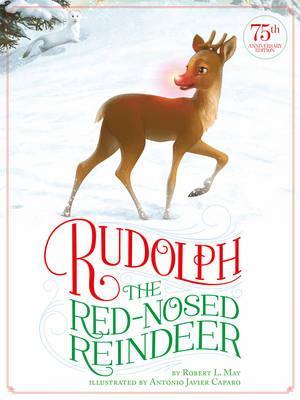
After reading Snowy’s Christmas, share the book of Rudolph
Before reading: Ask students to listen carefully to the story, prompting them to consider whether it is similar to another book they have recently heard.
After Reading: Discuss – are there similarities between Snowy’s Christmas and Rudolph the Red-Nosed Reindeer? Explain: Sally Murphy wrote Snowy’s Christmas as an attempt to tell an Australian version of the Rudolph story.
In Groups/Pairs: Students to complete a table noting how the two books are similar or different in areas including: Plot – Beginning, Middle, End/Characters/Setting/Illustration Style/Other. Groups to discuss which book they prefer, giving reasons.
Report back to class and discuss.
Writing: As a class, or in groups, work to rewrite another Christmas story or song into an Australian version. For example, the story of Frosty the Snowman.
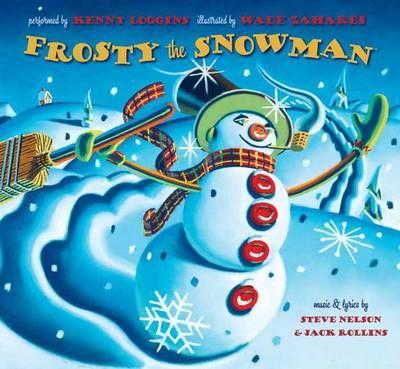
Other suggestions for using Snowy’s Christmas your classroom include:
Writing: What happens next? Students write a story about what happens to Snowy after Christmas. Does he go back to live with his mother? How do the other kanagaroos react? Does he have any more adventures?
Art: There are many ideas for Christmas and Kangaroo activities available online. For example, make this kangaroo planter as a pre-christmas craft activity.
Email the author (that’s me!) Your students can write to me through this website, and share their responses or ask questions.
Related Books
The Twelve Days of Aussie Christmas, by Colin Buchanan and Glen Singleton
We Wish You a Ripper Christmas , by Colin Buchanan and Roland Harvey
Christmas At Grandad’s Farm, by Claire Saxby and Janine Dawson
Christmas At Grandma’s Beach House, by Claire Saxby and Janine Dawson
A Very Wombat Christmas, by Lachlan Creagh
Mostly, I’d love to remind you that while I love to see my books used in classrooms, I also love to see kids just enjoying them. Reading a book should be pleasurable – whether it’s being used in the classroom or not. So allow your students to enjoy reading Snowy’s Christmas. And, if you do want a copy of Snowy’s Christmas I am offering signed copies, posted anywhere in Australia, for $15. You can contact me directly.
If you find this useful, or have any suggestions or comments, do leave a comment. And, if there is a particular book or year level or topic that you would like covered in a future edition of Teacher Tuesday, let me know.
October 19, 2017
Poetry Friday: Trash and Treasure
It’s been ages since I joined in on the fun of Poetry Friday, mostly because I spent a good chunk of this year finishing off and submitting my doctoral thesis exploring – you guessed it – children’s poetry. Now that my thesis, Belonging: A Place in and For Children’s Poetry has been examined and accepted and I am officially a doctor, I’ve been thinking for a few weeks that I must get around to jumping back in some Friday.
And then a weird piece of synchronicity happened this morning. I was walking on the beach, as I do most days, and admiring the various treasures on the sand. Some days there is little but sand on the shore and I instead admire the clouds, or the sparkling water, or the dolphins, or my thoughts, but some days, like today, the sea has abandoned something like this :

or this:

or even this:

for me to stop and admire (and photograph of course).
And the words of a poem of mine, Trash and Treasure started running through my head, and I knew that I should share the poem today for Poetry Friday, even though I knew I’d shared it before. So I came home, and here I am about to write this post, when I realised that not only have I shared the poem before, but I shared it this week a year ago! SO whether it is that this is the week of the year that the sea likes to prompt poetry, or whether it is sheer coincidence, I know I am meant to re-share Trash and Treasure with you here today. Enjoy!
And, for those who would prefer a text version, here it is:
Trash and Treasure
Each night
the sea deposits her rubbish
along the shore:
shells, sponge
even a starfish she no longer needs.
In the morning
her trash becomes my treasure.
(Copyright Sally Murphy)
It’s so lovely to back participating in Poetry Friday again. You can find the round up at A Day in the Life, where you will find links to other blogs having fun with Poetry Friday.
October 16, 2017
Teacher Tuesday: The Floatingest Frog in the Year 4 Classroom
Welcome to the third edition of Teacher Tuesday, where I match one of my books to a year level, and offer some activities for sharing the book in the classroom. In the first two weeks I shared activities for Looking Up and for Do Not Forget Australia.
This week I’m focusing on my very first picture book: The Floatingest Frog.
Using The Floatingest Frog in a Year Four Classroom
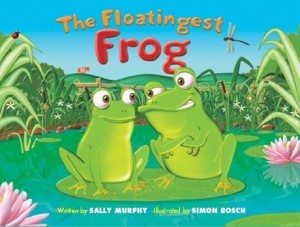 The Floatingest Frog, text by Sally Murphy, illustrations by Simon Bosch
The Floatingest Frog, text by Sally Murphy, illustrations by Simon Bosch
Published by New Frontier Publishing, 2004
ISBN: 9781921042546 (Paperback)
Format 24 page Picturebook, RRP $14.99
Available from good bookstores or here.
Blurb: Ferdinand the Frog wants to outdo his brother Frankie in every possible way. He can jump the farthest, croak the loudest, and even has the longest name! Sibling rivalry soon reaches hilarious heights when Ferdinand pushes his luck too far. Based on an Aesop’s fable, The Floatingest Frog is a cautionary tale about being too full of hot air.
Sally’s Recommended Grade Levels: Year K-5, but these suggestions focus on Year 4.
Themes/Topics:
Siblings
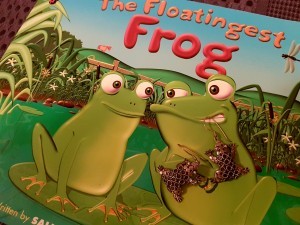
Frogs
Animals
Friendship
Aesop Fables
Humour
Wisdom
Curriculum Links:
Year 4 English
Recognise how quotation marks are used in texts to signal dialogue, titles and quoted (direct) speech (ACELA 1492)
Investigate how quoted (direct) and reported (indirect) speech work in different types of text (ACELA 1494)
During Re-Reading of the book, or using selected pages, ask students to identify how we know a character is speaking. Highlight opening and closing quotation marks, commas and attributions such as said/exclaimed/scoffed.
Rewrite selected sentences of dialogue on whiteboard or smartboard, demonstrating the correct placement of punctuation.
Create a worksheet with sentences from the text containing dialogue, with punctuation removed. Have students punctuate appropriately.
Writing: Write a conversation between Frankie and Ferdinand which does not happen in the book. OR write conversation where Frankie goes to introduce himself to the cow.
Make connections between the ways different authors may represent similar storylines, ideas and relationships (ACELT 1602): comparing different authors’ treatment of similar themes and text patterns, for example comparing fables and allegories from different cultures
Discuss how authors and illustrators make stories exciting, moving and absorbing and hold readers’ interest by using various techniques, for example character development and plot tension (ACELT 1605)
After Reading: Explain that The Floatingest Frog is based on an Aesop’s Fable, The Frog and the Ox. Discuss the elements of a fable – a story designed to teach a moral or message, after using animal characters and explicitly stating the moral.
Questions: Did any student identify the story as a fable on the first reading? How? Does The Floatingest Frog contain the elements of a fable?
Read Aesop’s fable: The Frog and the Ox. (There are several versions of this available online)
In groups/pairs construct a table exploring how the picture book is similar/different to The Frog and the Ox. Suggested headings: length, language, characters, dialogue, statement of moral.
Discuss: Why might an author use a fable to create a picture book? Which version did students prefer? Why did Sally use two frogs, rather than just one? Why did she change the ox into a cow?
Examine the book closely – using a story map or other process – to identify how the text attempts to make the original fable more engaging using dialogue, characterisation and action. Examine the illustrations closely to see how the illustrations add to the written words.
Questions: How has the author used dialogue tags/word choice/repetition/pacing to build an exciting story? Are their things which happen in the illustrations which do not happen in the words? What effect does this have? Why does the word ‘cow’ not appear in the text? How do we know it IS a cow?
Writing: Retell a different Aesop’s Fable as a narrative.
Plan, draft and publish imaginative, informative and persuasive texts containing key information and supporting details for a widening range of audiences, demonstrating increasing control over text structures and language features.
After Reading: Building on work on dialogue and on fables, have students write their own original animal story OR rewritten fable. Work through stages of planning, drafting, editing and publishing this narrative.
Year 4 Science
Biological sciences
Living things have life cycles (ACSSU072)
Living things, depend on each other and the environment to survive (ACSSU073)

The study of The Floatingest Frog can coincide with studies of the life cycle of the frogs. You can find Frog Printables here or at numerous other websites – or make your own.
Complement The Floatingest Frog with my non-fiction book Frogs: Awesome Amphibians, available here. You can see sample pages of the book HERE
Compare the language of the nonfiction book with the fiction book, integrating science and literacy activities into the one unit of work.
Other suggestions for using The Floatingest Frog in your classroom include:
Art/Technology: The art in The Floatingest Frog is created digitally. Experiment with drawing on whichever computer programs are available in your classroom.
Art: There are many ideas for frog craft, including frog origami. This Pinterest page has links to many easy, clever activities.
Email the author (that’s me!) Your students can write to me through this website, and share their responses or ask questions.
Related Books
Frogs: Awesome Amphibians, by Sally Murphy
The Pros & Cons of Being a Frog, by Sue deGennaro
Two Frogs, Chris Wormell
The Orchard Book of Aesop’s Fables, by Michael Morpurgo
Squids Will Be Squids, by Jon Scieszka
Unwitting Wisdom, by Helen Ward
Mostly, I’d love to remind you that while I love to see my books used in classrooms, I also love to see kids just enjoying them. Reading a book should be pleasurable – whether it’s being used in the classroom or not. So allow your students to enjoy reading The Floatingest Frog.
If you find this useful, or have any suggestions or comments, do leave a comment. And, if there is a particular book or year level or topic that you would like covered in a future edition of Teacher Tuesday, let me know.
October 9, 2017
Teacher Tuesday: Do Not Forget Australia for Year 5 Classrooms
Welcome to the second edition of Teacher Tuesday, where I match one of my books to a year level, and offer some activities for sharing the book in the classroom.
This week I’m focusing on one of my picture books: Do Not Forget Australia, With the centenary of the Battle of Villers-Bretonneux to be marked on ANZAC Day 2018, this is a good time to connect with this book if you haven’t yet, or to revisit it if you have.
Using Do Not Forget Australia in a Year Five Classroom
Do Not Forget Australia, text by Sally Murphy, illustrations Sonia Kretschmar 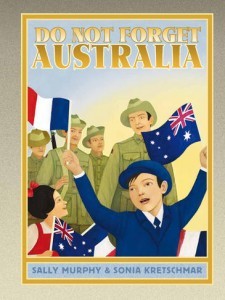
Published by Walker Books, 2012
ISBN: 9781921529863 (Hardcover)/ 9781922077097 (Paperback)
Format 32 page Picturebook, RRP $29.99 (Hardcover)/$16.99 (Papaerback)
Available from good bookstores or here.
Blurb: Henri lives in the French village of Villers-Bretonneux. Billy lives in Melbourne, Australia. These two little boys, who live thousands of miles away from each other, share one story that unites Villers-Bretonneux and Melbourne in history.
Sample Pages HERE
Publisher’s Teacher Notes HERE
Sally’s Recommended Grade Levels: Year 1-10, but these suggestions focus on Year5
Themes/Topics:
War
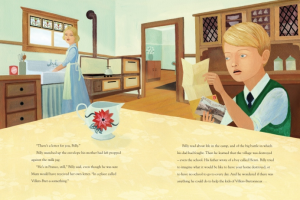
ANZAC Day
Friendship
Family
France
Australia
Victoria
Compassion
Curriculum Links:
Year 5 English
Identify aspects of literary texts that convey details or information about particular social, cultural and historical contexts (ACELT1608)
Before Reading: Make predictions on time period and setting of the book based on title and front over.
During and After Reading: Focus on aspects of text and illustrations which show that the book is set in 1918 – including colour palette, clothing, transport, communication methods.
Questions: Why can’t the two boys meet in person?
What is the connection between Henri and Billy?
Use internet sources (such as The Schoolhouse Museum) to compare school life today with that of 1918. Create a table which compares aspects including classroom setup, size of classes, subjects taught, school attire, school rules, stationery used and more.
Writing: Rewrite your existing class rules as if it was 1918
Recognise that ideas in literary texts can be conveyed from different viewpoints, which can lead to different kinds of interpretations and responses (ACELT1610)
During Reading (and on rereading): Discuss the changes in viewpoint – from Henri to Billy and back again. What visual cues are there for these shifts? For example, examine the colour palette used in the illustrations
After Reading: Discuss why the author might have chosen to use two viewpoints rather than one? Why use third person voice rather than first person? Why tell a war story from the viewpoint of children rather than from, say, a soldier, or adult from the village.?
In Groups: Each group to work through the text, focussing on how we learn what the adults are feeling. – half the groups to focus on Billy’s Dad, the other groups on Henri’s Mum. Report back and discuss.
Writing: Tell the story from the point of view of one of the adult characters OR in the first person voice of one of the children.
Write the postcard that Billy receives from his father. There is a printable stencil for this activity HERE.
Use comprehension strategies to analyse information, integrating and linking ideas from a variety of print and digital sources (ACELY1703)
Plan, draft and publish imaginative, informative and persuasive print and multimodal texts, choosing textstructures, language features, images and sound appropriate to purpose and audience (ACELY1704)
Recap: From reading the story, what do students know about the battle of Villers-Bretonneux and the rebuilding of the school?
Give students a blank table, or have them create one, with three columns: Story, Back of Book Notes, Video. Provide some subheadings: Dates, Key Events etc. Have them note what they know about the key events of 1918 from the fictional story. Then read the back of book notes, with students using the second column to note any new facts. In groups, students can then examine the back of book notes themselves and add any facts they may have missed. Lastly, have them watch a video about the events – there are several on Youtube, including this one , which is made by a young researcher. Again, have students complete the table.
Discuss: Which source provided the most information? Which was the most entertaining? Which one helped them to connect with the people involved?
Writing Ideas: Write a recount of the events of the battle of Viilers-Bretonneux, OR the destruction and rebuilding of the school, using notes.
Write two news reports which Billy might have read: One reporting on the Battle, and the other reporting on the reopening of the School
Other suggestions for using Do Not Forget Australia in your classroom include:
Explore transport and communication – comparing 1918 to 2017/18 – look at items including time to travel between Australia and France, modes of transport, forms of communication (telephone/email/mail/internet/television/telegram)
Life stories: research the story of one Australian soldier in WW1
Art: Experiment with using different colour palette for different moods and time periods.
Writing: Tell the story of another historical event through the eyes of a fictional child character
Email the author (that’s me!) Your students can write to me through this website, and share their responses or ask questions.
Related Books
Australia’s Great War: 1915, by Sally Murphy
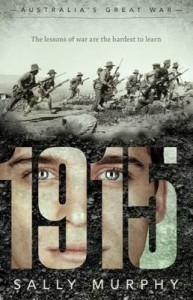
Australia’s Great War: 1918, by Libby Gleeson (to be released in 2018)
Lighthouse Girl and Light Horse Boy, by Dianne Wolfer and Brian Simmonds
In Flanders Fields, by Norman Jorgensen and Brian Harrison-Lever
Meet the ANZACS, by Claire Saxby and Max Berry
Simpson and His Donkey, by Mark Greenwood and Frane Lessac
Mostly, I’d love to remind you that while I love to see my books used in classrooms, I also love to see kids just enjoying them. Reading a book should be pleasurable – whether it’s being used in the classroom or not. So allow your students to enjoy reading Do Not Forget Australia.
If you find this useful, or have any suggestions or comments, do leave a comment. And, if there is a particular book or year level or topic that you would like covered in a future edition of Teacher Tuesday, let me know.
October 2, 2017
Teacher Tuesday: Looking Up Ideas for Year 3 Classrooms
In a new feature I’m planning on running regularly here on my website, I am matching my books with curriculum links. Each week I will feature one of my books, with curriculum links for a particular year group and ideas for how that book can be used to address them. If there’s a particular book or year group or curriculum area you’d like to see covered, drop me a line and I will see what I can do. First up, I’m featuring one of my newest books, Looking Up. Here goes:
Using Looking Up in a Year Three Classroom
Looking Up, by Sally Murphy, with illustrations by Aska 
Published by Fremantle Press, 2017
ISBN 9781925164572
Format, Paperback 72 pages, RRP $14.99
Available from good bookstores or here. Also available as an ebook.
Blurb: Pete is hoping – desperately hoping – for a telescope. There’s nothing he wants more for his birthday. But when a mysterious card arrives in the mall, what Pete wants is turned upside down.
Sample Chapter HERE
Publisher’s Teacher Notes HERE
Sally’s Recommended Grade Levels: Year 2-6, but these suggestions focus on Year 3
Themes/Topics:
Grandparents
Family
Stars
Astronomy
Telescopes
Family
Forgiveness
Friendship
Empathy
Mysteries
Birthdays
Curriculum Links:
Year 3 English
Understand how different types of texts vary in use of language choices, depending on their purpose and context (for example, tense and types of sentences) (ACELA1478)
Understand that verbs represent different processes, for example doing, thinking, saying, and relating and that these processes are anchored in time through tense (ACELA1482 )
Chapter Two
In groups, identify the verbs used in this chapter. Use different colours to identify each of doing, thinking, saying and relating. As class brainstorm to build a word bank of verbs – for example ‘Listening”’ (p. ) could lead to ‘hearing’. In groups, or individually, have students change selected verbs to past tense and/or future tense.
Writing: Rewrite a scene in present tense. How did the language change? Which did students prefer?
Rewrite the same scene as a news report. How did the language change? Was it more formal? Did it require additional information? Were some parts of the scene left out?
Compare the language and sentence structure of the original scene with that of a news report. Look at differences in sentence complexity, language choice etc.
Draw connections between personal experiences and the worlds of texts, and share responses with others (ACELT1596)
Before reading, discussion questions can focus on children’s experiences with grandparents or great-grandparents, as well as on birthdays, wishlists and receiving mail.:
How many grandparents do you have?
Do any of them live far away?
Do you have grandparents you have never met?
What is your favourite memory with a grandparent?
What’s the favourite birthday/Christmas/other present you have received?
What kind of letters does the postman/postwoman deliver?
Have you ever received a letter addressed to you?
During reading
Chapter Two –p. 11 stop and have students guess what might be in the envelope
p. 14 After he removes the card, but before we find out who it is from, have students’ make predictions.
After Reading the Chapter:
Discuss: Why might Pete not know he has a grandfather?
Chapter 9
p. 58 Stop at the arrow. Make predictions. Will Pete get the telescope? Why/why not.
After the chapter:
How do students feel about Pete not getting the telescope – and his reaction?
Have they ever not got something that they really wanted?
Writing suggestions:
Write a recount of a visit to a grandparent, or a favourite birthday memory.
Write a wishlist of things students would like to receive for their next birthday/Christmas. Then use the internet or catalogues to work out how much their list might cost.
Develop criteria for establishing personal preferences for literature (ACELT1598)
Before reading: Looking at the cover, have students predict whether or not they will enjoy this book. Why/why not? In writing books, have them write their predictions regarding enjoyment of the text
During Reading: After each reading session, discuss students’ reactions to the text. Are they enjoying it? DO they think that what happened is interesting/scary/boring? Are they keen to know what will happen next? How do they feel about Pete? Mum? Grandad?
After Reading: Discuss students’ reactions to the ending. In writing books, write about their responses to the book and how these differ from their feelings before.
Extension: Write a book review. (For examples, see www.aussiereviews.com)
Identify the point of view in a text and suggest alternative points of view (ACELY1675)
During reading:
After Chapters 4, 6 and 8, discuss Pete’s reactions to these events, and how Mum would be feeling. Draw a picture of Mum (or teacher can provide) with thought bubbles for what Mum might be thinking but not saying.
After Chapter 5, discuss how it might be for Grandad to meet Pete for the first time. What is he thinking and feeling?
Writing: Rewrite one of these scenes from the point of view of the other character.
Other suggestions for using Looking Up in your classroom include: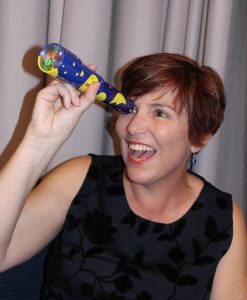
Make birthday/Christmas cards
Make origami stars – instructions here.
Make a Constellation Projector like this one here.
Email the author (that’s me!) Your students can write to me through this website, and share their responses or ask questions.
Related Books
Featuring Grandparents
Pearl Verses the World, by Sally Murphy
Grandpa and Thomas, by Pamela Allen
Granny Grommet and Me, by Dianne Wolfer and Karen Blair
Love From Grandma, by Jane Tanner
Mostly, I’d love to remind you that while I love to see my books used in classrooms, I also love to see kids just enjoying them. Reading a book should be pleasurable – whether it’s being used in the classroom or not. So have fun with Looking Up!
I’d love to know if you found these notes useful, or if you have any other suggestions, or if there’s a different book you’d love to see featured in this way. Leave a comment!
Submissions Tips: Is Crossing Your Fingers the Best Way to Get Published?
I had an email today from a new writer who is trying to get published (aren’t we all) and, in replying to one of their questions, I realised it was probably a good topic for a quick blog post. SO, here goes.
First, the question:
In terms of submitting your work to different publishers, do you have an approach or strategy? (I.e. to increase your chances of getting noticed?) Or is it just a matter of submitting to the most appropriate publishers and crossing your fingers?
And now, my answer – a longer version of my email reply.
Yep, cross your fingers, hold your tongue at the right angle, sprinkle fairy dust, or salt, or glitter over your right shoulder, then turn around three times, tap your feet together and make a wish. Then post  that submission and you WILL land a publishing deal.
that submission and you WILL land a publishing deal.
Okay, maybe I’ve never done all of those things, but sometimes it feels like getting accepted is such a lottery that I might as well do that routine, as anything else I’ve tried seems just as hit and miss.
But really, in my experience, publishers mainly want only a few things. The number one thing they are looking for is a well written book, and the next most important things are your easiness to work with and whether you (as well as your story) will be marketable.
So, assuming that you DO have a well written book (that could be a whole nother blog post or ten) here are a few things I’ve gleaned over the years that maybe, just maybe, will increase your chances just a tiny bit of having your manuscript accepted.
Research publishers. Note that my emailer used the term ‘most appropriate publishers’. She’s already well on the way to getting it right. Because not every publisher is appropriate for your book.Save yourself time by spending time before you submit on finding out which publishers publish the kind of book you have written. If they don’t publish picture books, don’t send them one. If they don’t publish poetry, don’t send them your collection. But even more specifically, if you’ve written a middle grade fantasy, and their list has no fantasy on it, maybe it’s not something they’re interested in.
Follow submission guidelines. Every publisher has guidelines, even though sometimes they are hard to find on their websites. You may have to look into the deepest darkest recess of the site before you find them – sometimes under the ‘contact us’ page, sometimes on an ‘faq’ page, sometimes somewhere even trickier. (nb if there ARE no guidelines, you might take the hint, OR you might send an email through the contact form to find out if they have any). Once you find the guidelines, stick to them. If they say ‘send one manuscript’, send one, not three, not five, and certainly not ten. If they say double spaced, 12 point font, do it. Do they only want a synopsis? Send that. Show the publisher that you are easy to work with, and can follow instructions.
Show that you are marketable. What is it that YOU bring to the table? Lots of writers (of all levels of experience) find this one challenging. After all, isn’t it the publisher’s job to market your book (and again, I could write a billion blog posts about this). If you are accepted, the publisher will do some marketing. But, if they know that YOU are also going to be promoting your book, then you become a great proposition. So, do you have a social media presence? A website? A teaching background? Anything that shows you are going to be able to promote your book. This is not where you tell the publisher about your wonderful idea for them to produce a stuffed toy/computer game/movie trailer. This is where you show what you can do yourself. And it doesn’t have to be a hundred different things – just a few things done well.
I said that I’m presuming you have a wonderful manuscript, but before you hit send, make sure it is absolutely as best it can be. Proofread it. Compare it to other books you’ve read – you have read books in the same genre/format/age group that you are targeting, haven’t you? It’s easy to be so excited by your creative genius that you don’t take the time to get it perfect (I know I have made this mistake!) There really is no rush. If your work is brilliant, it will find a home somehow.
Lastly, if you really really really want to get published, don’t set all your hopes on one book or one publisher. You can expect to get rejected. It’s part of the game. And the book you are so certain will be the one, often isn’t. Think of rejections as a badge of honour. There is no plot against you. There are no ‘gatekeepers’ wanting to keep you out. What there are are publishers who want to publish books to make money, and an almost unlimited number of manuscripts coming their way. They have to choose. It isn’t personal, but it is a game of persistence, and of working hard to tip the odds in your favour, by doing things like one to four above.
And, of course, it can’t hurt to cross your fingers. I’d avoid the glitter, though. It’s hard to vacuum up.
October 1, 2017
September 30, 2017
What I Read in September
Another month has flown by, and lots more reading has been done. This month I got through 25 books, everything from gorgeous new picture books (I only count ones which I have read AND reviewed for this monthly list) to an book called The 5 Second Rule[image error], from Mel Robbins, a leading motivational speaker in the United States (and internationally). I can see why her book and her presentations – on Youtube and in-person are so popular. She has inspired me to get out of bed earlier and get stuff done this month. So thanks Mel – after reading the book, I even visited the dentist, which I’d put off for years.
Anyway, here’s what I read this month.
Picture Books
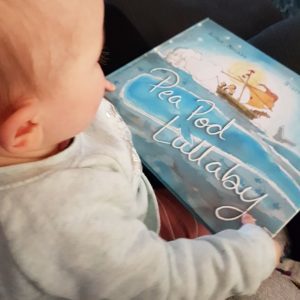
One of the Murphling grandbabies loved this one.
Nanna’s Button Tin, by Dianne Wolfer & Heather Potter
Pea Pod Lullaby, by Glenda Millard & Stephen Michael King
My Meerkat Mum, by Ruth Paul
Boy, by Phil Cummings & Shane Devries
The Cat Wants Cuddles, by P. Crumble & Lucinda Gifford
The Very Cranky Bear, by Nick Bland
I Want to Be in a Book, by Narelle Oliver
Younger Readers
Polly & Buster: The Wayward Witch & the Feelings Monster, by Sally Rippin
Chook Doolan: On the Road, by James Roy
Chook Doolan: Un-happy Camper, by James Roy
Chook Doolan: Up and Away, by James Roy
Chook Doolan: Let’s Do Diwali, by James Roy
Twin Trouble, by Jacqueline Wilson
Blossom, by Tamsin Janu
Miniwings: Glitterwing’s Book Week Blunder, by Sally Sutton
Miniwings: Whizz’s Internet Oopsie, by Sally Sutton
Charlie and the Karaoke Cockroaches, by Alan Brough
You Just Wait: A Poetry Friday Power Book, by Sylvia Vardell & Janet Wong
The Beach Shack Cafe, by Belinda Murrell
Young Adult
Bro, by Helen Chebatte
Nothing, by Annie Barrows
My Lovely Frankie, by Judith Clarke
Losing It, by Julia Lawrinson
Adult
The 5 Second Rule, by Mel Robbins
The Story of Our Life, by Shari Lo
Have a great October. Two months till summer!
September 27, 2017
Two Panels, and Five Panelling Tips
I was lucky enough to be part of two panel sessions in the past month. First, I was on a panel discussing writing children’s poetry at the Queensland Poetry Festival and, more recently, I was part of a panel discussing empathy in fiction as part of Research Week at Edith Cowan University.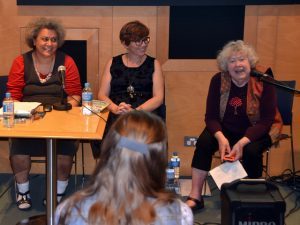
I love speaking about books and writing and while I absolutely love talking about my own books, the opportunity to be on a panel offers a different opportunity, which I love. While both panels allowed me to apply my own work and experience to the topics at hand, they also offered the opportunity to learn and consider how other people work, and particularly how other writers, sometimes working in different genres or for different audiences, approach similar challenges.
In Queensland, I the panel consisted of myself, June Perkins (who also convened the panel), and JR Poulter – all of us children’s poets who write in other genres as well – and chair Dr Virginia Lowe, a children’s literature expert. We discussed topics including how children’s poetry differs from that written for adults, why poetry is important, and our own writing processes. This was followed by a reading session, where we each shared from our own work, as well as questions from the audience (including both adults and children).
In Bunbury, the panel consisted of myself, Dr Vahri McKenzie (a creative arts academic and writer, and also the supervisor of my recent PhD studies) and Lesley Thiele (a fabulous up and coming writer, whose short fiction has had much success) , and chair Narelle De Boer, a PhD candidate and lecturer in the creative arts. We each read from recent works, and discussed the topic of empathy and how we develop it in our writing, as well as answering lots of thought provoking questions on a range of topics from the audience. For me, this was a different opportunity because I was the only panelist who specialises in writing for children, so it was interesting to be able to see (and demonstrate to the audience) similarities and differences in the way we work.
Although the two panels were quite different, they both ran well, I think because of the strength of the organisation behind them. Although I can’t take credit for that, my observations of how to make a panel work might come in handy if you are appearing on one yourself – or planning one for a literary event:
A strong, passionate, moderator is essential. Both Virginia and Narelle knew their stuff, had lots to contribute, and kept the conversation going.
Diversity of panellists makes for interest. Unusually, both panels I was on were all female, but we came from a range of backgrounds, and had different publishing, professional and personal experiences. If panellists match too closely there may not be enough to discuss – too much “me too-ing”. This wasn’t a problem on either panel I was on.
Promote the event to ensure you have an audience. Neither panel had a huge audience, being niche events, but the people who were there were there because they were keen to hear what we had to say. Some had come through word of mouth, others through social media links. Neither session had a big advertising budget, but enthusiastic sharing drew people in.
Don’t over prepare. Let the conversation flow depending on interactions of the panellists and according to audience input. Both panels seemed to flow organically, although there was good ground work laid before the event to ensure we knew what we would/could discuss.
Lastly, try to relax and enjoy it. Sometimes things go wrong – sound systems don’t work, IT seems like it won’t function, you forget to make a point – but generally, the audience doesn’t notice. And if they do, they are very forgiving. Remember, they are there because they are interested in what you have to say: not because they want to judge you.
If you have any tips for successful panels, leave a comment. I’d love to hear what works for you!
September 25, 2017
Bookmonth Wrap-up
I wanted to sit and write a post about all the awesome schools and libraries I visited during August, and into September, for Bookweek – which actually stretches over the whole month. But somehow, my post turned into a poem, which I hope captures what I do and why I do what I do. So here it is:
A Book Week Poem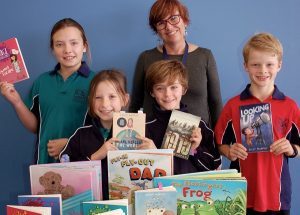
Bookweek comes but once a year
Visiting schools both far and near
To tell the world that’s reading’s fun
And spread the joy to every one.
I read my books and talk a lot
Answer questions on the spot
Laugh and cry and laugh some more
And meet young readers by the score.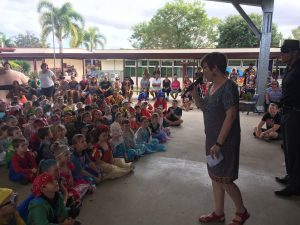
Give clues for writing for keen minds
And share some favourite literary finds
Not minding (too much) early morns
Leaving home before day dawns
And driving driving to get where
I need to be to chat and share
Or flights that take me far from home
I love to travel and to roam.
My voice struggles to get through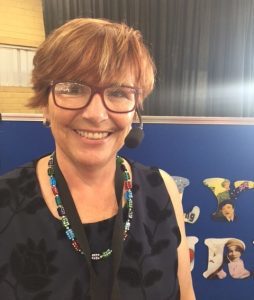
But lozenges and water too
Keep me going every day
To say the things I want to say.
And as one week stretches to four
And back and eyes and feet grow sore
I still feel pumped by what I do
And draw such energy from you
The readers who I get to meet
On this awesome Bookmonth beat.
Thanks to every school and library which hosted me over August, and into September. And a special thanks to the hundreds of young readers who engaged so enthusiastically in my sessions.

I love my job!

